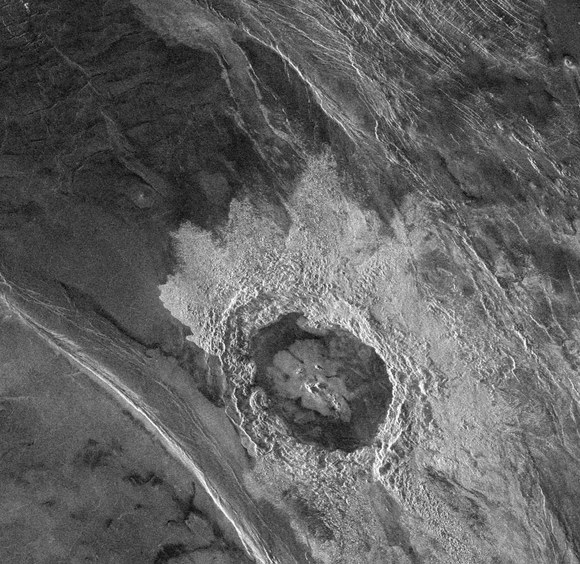

Here’s this week’s ‘Where In The Universe’ challenge. I have a soft spot in my heart for craters. And the crater pictured here is one of the most gorgeous examples of a crater you’ll see. But just where in the solar system is this crater? When I worked at a science museum, one of the first activities I ever did with children was to make craters. Just take a small tub, put in a few cups of flour and sprinkle cocoa powder on top. Then let the kids lose with impactors of all sizes and have them drop them (from the same height at first) and let them observe the parts of a crater (the rim, ejecta, rays, and sometimes even the step-like features on the walls). The kids loved this activity (you get to throw things and make a mess), but they also learned a lot about craters and how craters can provide information about the history of a planet or moon. So, back to the image, and “A crater I may contemplate” (see the source of that quote below after you’ve made your guess). Is this crater on a planet or a moon, and which one?
This crater is on Venus, and is named Dickinson Crater. This crater is 69 kilometers (43 miles) in diameter, and located in the northeastern Atalanta Region of Venus at 74.6 degrees north latitude and 177.2 east longitude. This crater is quite complex, characterized by a floor with alternating dark and bright materials. Rough but bright ejecta extend all around the crater, except to the west,which may indicate that the impactor that produced the crater came from the west. Extensive radar-bright flows that emanate from the crater’s eastern walls may represent large volumes of impact melt, or they may be the result of volcanic material released from the subsurface during the cratering event.
The crater was named after Emily Dickinson, an American poet, who wrote a poem about volcanoes and craters:
Volcanoes be in Sicily
And South America,
I judge from my geography.
Volcanoes nearer here,
A lava step, at any time,
Am I inclined to climb,
A crater I may contemplate,
Vesuvius at home.
Emily Dickinson, ‘Volcanoes be in Sicily’, from The Single Hound: Poems of a Lifetime (Boston: Little, Brown, 1914), p. 125.
How’d you do?
Full size image from NASA Photojournal
The journey to Mars will subject astronauts to extended periods of exposure to radiation during…
Anthropogenic climate change is creating a vicious circle where rising temperatures are causing glaciers to…
Satellites often face a disappointing end: despite having fully working systems, they are often de-orbited…
Astronomers have known for some time that nearby supernovae have had a profound effect on…
How can we explore Saturn’s moon, Enceladus, to include its surface and subsurface ocean, with…
Have you ever wondered how astronomers manage to map out the Milky Way when it's…